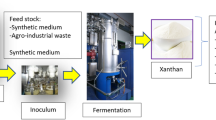Abstract
Xanthan gum is a complex exopolysaccharide produced by the plant-pathogenic bacterium Xanthomonas campestris pv. campestris. It consists of D-glucosyl, D-mannosyl, and D-glucuronyl acid residues in a molar ratio of 2:2:1 and variable proportions of O-acetyl and pyruvyl residues. Because of its physical properties, it is widely used as a thickener or viscosifier in both food and non-food industries. Xanthan gum is also used as a stabilizer for a wide variety of suspensions, emulsions, and foams. This article outlines aspects of the biochemical assembly and genetic loci involved in its biosynthesis, including the synthesis of the sugar nucleotide substrates, the building and decoration of the pentasaccharide subunit, and the polymerization and secretion of the polymer. An overview of the applications and industrial production of xanthan is also covered.
Similar content being viewed by others
Author information
Authors and Affiliations
Additional information
Received: 18 March 1998 / Received revision: 29 April 1998 / Accepted: 30 April 1998
Rights and permissions
About this article
Cite this article
Becker, A., Katzen, F., Pühler, A. et al. Xanthan gum biosynthesis and application: a biochemical /genetic perspective. Appl Microbiol Biotechnol 50, 145–152 (1998). https://doi.org/10.1007/s002530051269
Issue Date:
DOI: https://doi.org/10.1007/s002530051269




